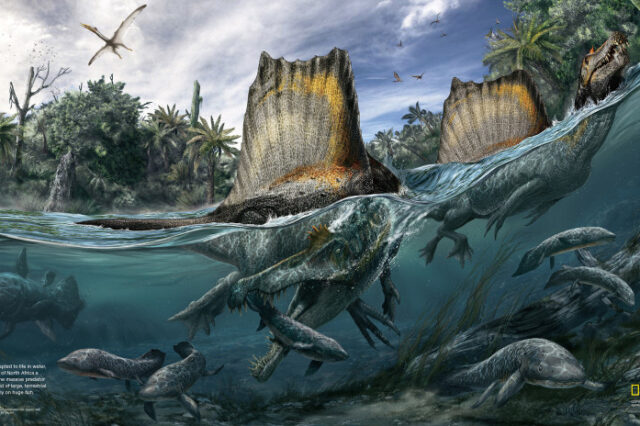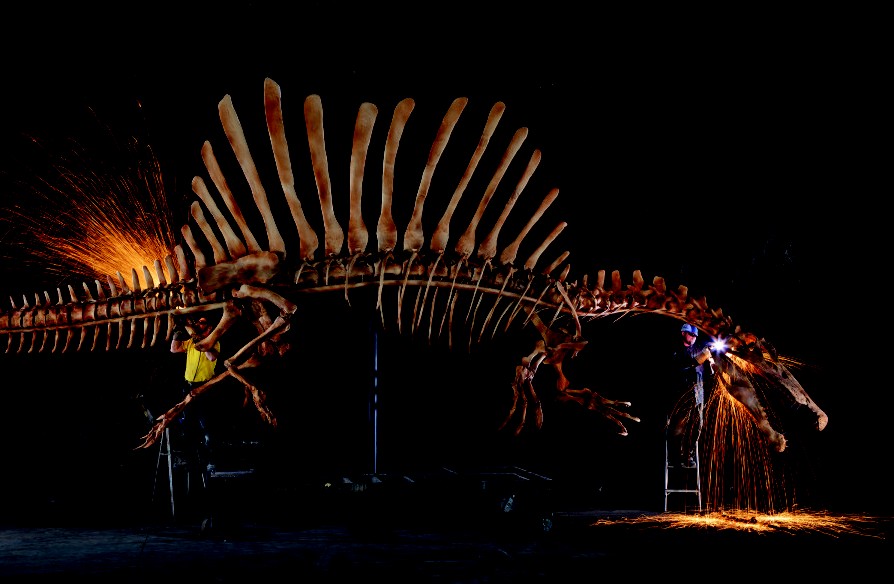Ιστορική ανακάλυψη: Σπινόσαυρος, o πρώτος αμφίβιος δεινόσαυρος

Ανακαλύφθηκε ο πρώτος αμφίβιος δεινόσαυρος, ο Σπινόσαυρος. Έτρωγε ολόκληρους καρχαρίες (Vid+Pic)
- 12 Σεπτεμβρίου 2014 10:28
Στη στεριά ήταν τρία μέτρα μεγαλύτερος από τον τρομερό Τυραννόσαυρο, πράγμα που τον έκανε επίφοβο θηρευτή. Στη θάλασσα κολυμπούσε σαν ψάρι και έκανε μια χαψιά έναν ολόκληρο καρχαρία. Ο λόγος για τον 15μετρο σαρκοβόρο τετράποδο Σπινόσαυρο, βάρους επτά τόνων, ένα πλάσμα βγαλμένο από τις σελίδες των πιο τρομακτικών μύθων της ανθρωπότητας.
Είναι ο πρώτος αμφίβιος δεινόσαυρος που ανακαλύπτεται το απολίθωμά του και το μεγαλύτερο αρπακτικό που υπήρξε ποτέ στη Γη (αν και μικρότερος από τους άκακους γιγάντιους φυτοφάγους δεινόσαυρους). Αν κανείς σήμερα τρέμει στην εικόνα του μικρού πτερύγιου του καρχαρία που εξέχει από το νερό, υπάρχουν και χειρότερα: Ο Σπινόσαυρος, που είχε μουσούδα κροκόδειλου, διέθετε στην πλάτη του ένα τεράστιο πτερύγιο ύψους δύο μέτρων σαν ιστίο, που εξείχε για τα καλά, όταν κυνηγούσε… καρχαρίες.
Η σημαντική ανακάλυψη, που παρουσιάστηκε στο κορυφαίο επιστημονικό περιοδικό «Science», σύμφωνα με το BBC, τα πρακτορεία Ρόιτερς και Γαλλικό και το «New Scientist», έγινε στη Μαροκινή Σαχάρα από διεθνή ομάδα επιστημόνων με επικεφαλής τον παλαιοντολόγο Νιζάρ Ιμπραχίμ, του Πανεπιστημίου του Σικάγο. «Ήταν σαν να μελετούμε ένα εξωγήινο ζώο από το διάστημα. Δεν μοιάζει με κανέναν άλλο δεινόσαυρο που έχω δει ποτέ», δήλωσε ο Νιζάρ Ιμπραχίμ.
Ο «Σπινόσαυρος ο Αιγυπτιακός» (όπως είναι η πλήρης ονομασία του), το σώμα του οποίου έμοιαζε με τεράστια πάπια, ζούσε πριν από περίπου 95 έως 97 εκατ. χρόνια. Αρχικά ήταν καθαρά στεριανό είδος, αλλά σταδιακά εξελίχτηκε για να κυνηγά ψάρια και στο νερό με τα γιγάντια δόντια του. Από ένα σημείο και μετά πιο άνετα κολυμπούσε, παρά περπατούσε στην ξηρά.
Η πρώτη ένδειξη για την ύπαρξη του Σπινόσαυρου ήλθε στο φως το 1912, όταν ο Γερμανός αιγυπτιολόγος Ερνστ Φράιχερ Στρόμερ φον Ράιχενμπαχ ανακάλυψε τα πρώτα απολιθώματα στην Αιγυπτιακή Σαχάρα. Όμως αυτά τα πολύτιμα ευρήματα καταστράφηκαν το 1944, στον δεύτερο Παγκόσμιο Πόλεμο, κατά τον βομβαρδισμό του Μουσείου του Μονάχου από βρετανικά αεροπλάνα.
Όμως, ο παλαιοντολόγος του Πανεπιστημίου του Σικάγο μπόρεσε να μελετήσει ό,τι διασώθηκε από τις σημειώσεις και εικόνες του Ερνστ Φράιχερ Στρόμερ στο οικογενειακό κάστρο του τελευταίου στη Βαυαρία, καταφέρνοντας τελικά να ανακαλύψει νέα απολιθώματα στην ανατολική Μαροκινή Σαχάρα, στην περιοχή Κεμ-Κεμ. Στο μακρινό παρελθόν, αυτή η περιοχή ήταν καταπράσινη αλλά άκρως επικίνδυνη, καθώς φιλοξενούσε ένα τεράστιο δίκτυο μεγάλων ποταμών, γεμάτων από επτάμετρα ιπτάμενα ερπετά, αρπακτικούς δεινόσαυρους, καρχαρίες, 11μετρους κροκόδειλους και άλλα υδρόβια πλάσματα.
Αν και τα απολιθώματα που βρέθηκαν, δεν είναι πλήρη, οι επιστήμονες κατάφεραν, χάρη στη σύγχρονη ψηφιακή τεχνολογία, να «αναστήσουν» στον υπολογιστή την εικόνα του Σπινόσαυρου. Μία τρισδιάστατη αναπαράστασή του σε πραγματικό μέγεθος θα παρουσιαστεί για πρώτη φορά σε νέα έκθεση του Εθνικού Γεωγραφικού Μουσείου της Ουάσιγκτον (12/9/14 έως 12/4/15). Παράλληλα εντός του Νοεμβρίου θα προβληθεί το πρώτο σχετικό ντοκιμαντέρ που γύρισαν το «National Geographic» και η NOVA.
Το 2001, το φιλμ «Τζουράσικ Παρκ 3» περιλάμβανε μια εντυπωσιακή σκηνή όπου ένας τεράστιος δεινόσαυρος σαν Σπινόσαυρος επιτίθετο σε έναν Τυρανόσαυρο Ρεξ. Όμως, υπάρχει μια επιστημονική ανακρίβεια: οι Τυρανόσαυροι ζούσαν στη Βόρεια Αμερική περίπου 30 εκατ. χρόνια μετά την εξαφάνιση του Σπινόσαυρου, ο οποίος περιφερόταν στη Βόρεια Αφρική.








































